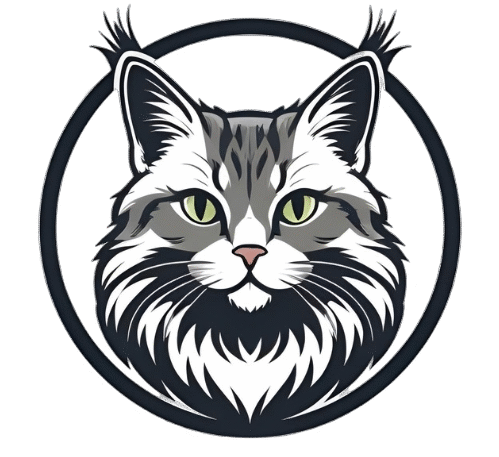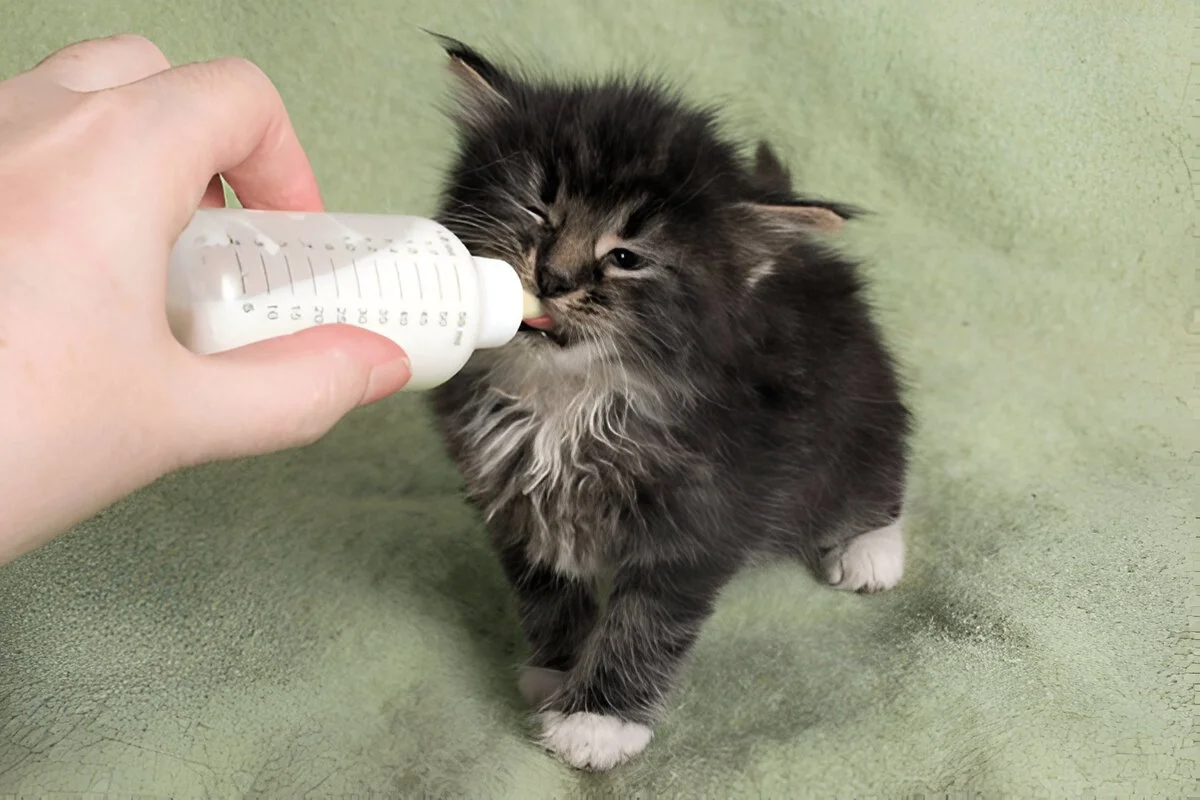Maine Coon cats are well-known for their size, affectionate fluffy coats, and their dog-like personality. However, what really makes them unique is their growth pattern, which is slow, sometimes awkward, and unpredictable.
If you’re raising a Maine Coon, you probably have a zillion questions such as:
Why do they grow so slowly?
How can you tell if your kitten is on track?
What should you expect at each stage?
Trust me, understanding the Maine Coon Cat Growth Stages is one of the keys to enjoying the process and ensuring your cat thrives.
This guide will take you through every Maine Coon Cat Growth Stage, weaving in facts and personal recommendations.
- Quick Reference Table: Maine Coon Growth Stages
- 5 Essential Maine Coon Cat Growth Stages
- 1. Kittenhood (0–6 Months)
- 2. Juvenile Stage (6 Months–2 Years)
- 3. Young Adult (Between 2-4 Years)
- 4. Prime Adulthood (Age 4-6)
- 5. Senior Years (7+ Years): The Sage
- Factors That Affect Stages of Growth for the Maine Coon Cat
- Tracking & Monitoring Growth: Tools and Red Flags
- Embracing Maine Coon Cat Growth Stages
Quick Reference Table: Maine Coon Growth Stages
This table offers a reliable reference for you to consider as you measure your Maine Coon through each exciting developmental stage. The weight ranges for males and females are average lengths by age, along with a few notes about what happens at each age.
| Stage / Age | Male Weight Range | Female Weight Range | Typical Milestones & Notes |
| Newborn (0–1 week) | 90–170 g (0.2–0.4 lb) | 90–150 g (0.2–0.33 lb) | Eyes and ears closed, totally dependent on mother, rapid weight gain begins |
| 1 week | 190–290 g (0.4–0.64 lb) | 160–260 g (0.35–0.57 lb) | Eyes begin to open, first wobbly movements |
| 1 month (4 weeks) | 620–820 g (1.4–1.8 lb) | 550–740 g (1.2–1.6 lb) | Exploring, playing, starting to eat solid food, coordination improves |
| 2 months (8 weeks) | 1.1–1.6 kg (2.4–3.5 lb) | 1.0–1.4 kg (2.2–3.1 lb) | Weaning off mother’s milk, socialization, first vaccinations |
| 3 months (12 weeks) | 1.8–2.3 kg (4–5 lb) | 1.4–1.8 kg (3–4 lb) | Rapid growth, playful, learning boundaries, baby teeth present |
| 6 months | 3.4–6 kg (7.5–13 lb) | 3.1–4.3 kg (6.8–9.5 lb) | Long legs, “lanky” look, permanent teeth coming in, high energy |
| 9 months | 4.5–7 kg (10–15.4 lb) | 3.6–5 kg (8–11 lb) | Growth rate slows, muscle development increases, coat thickens |
| 12 months (1 year) | 5.8–9 kg (12.8–19.8 lb) | 3.6–5.4 kg (7.9–11.9 lb) | 75–80% of adult size, playful but more coordinated, mane and tail fluffier |
| 2 years | 6.5–10 kg (14–22 lb) | 4–6 kg (8.8–13.2 lb) | Growth slows further, “filling out” with muscle, adult personality emerges |
| 4–5 years (full grown) | 6.8–11.3 kg (15–25 lb) | 4.5–6.5 kg (10–14.3 lb) | Full adult size, thick mane, broad chest, majestic appearance |
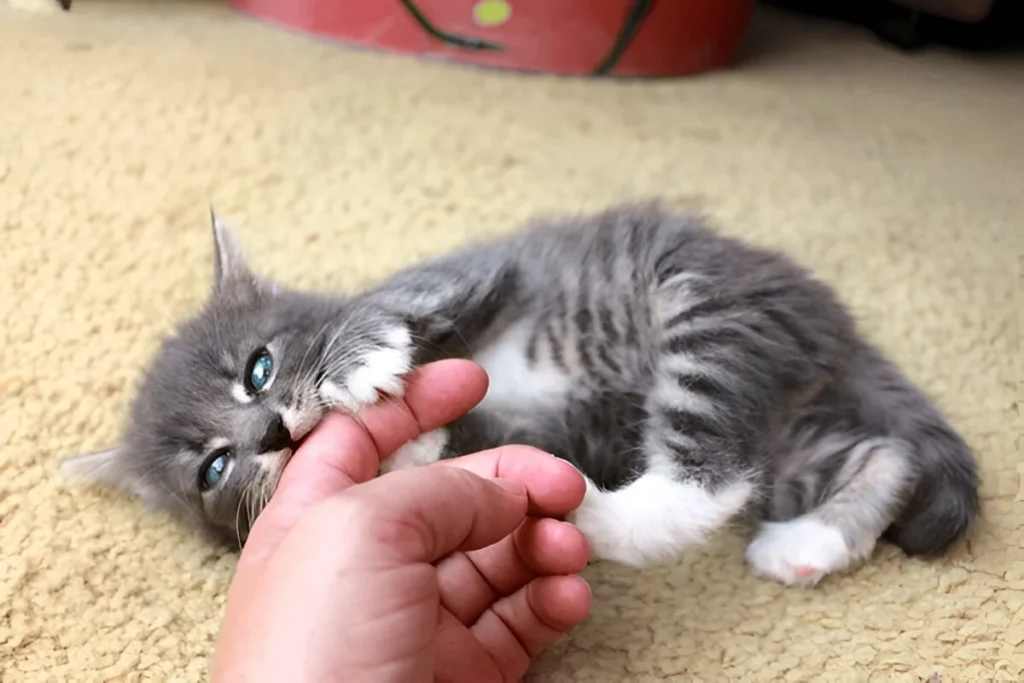
5 Essential Maine Coon Cat Growth Stages
Maine Coon growth stages are unique—these gentle giants take years to fully mature, and knowing what to expect makes the journey even more rewarding.
1. Kittenhood (0–6 Months)
The first six months of a Maine Coon’s life is a fast-paced journey. Newborn kittens are so small—about the size of your hand—and so totally dependent on their mother for warmth and food.
Their eyes remain closed for the first week or two, and their ears remain folded tightly.
However, by the end of week two, their eyes open, and before long, they are wobbling about on “not-quite-steady” legs, and viewing their new world for the first time.
Watching growth at this stage is an almost magical experience. Kittens typically double their weight in the first week.
By the time they are one month old, kittens are already beginning to take their first steps toward playing with siblings, pouncing on invisible prey, and showcasing their budding personalities.
Their coats will start to fluff out, and you should be able to see the beginnings of the ear tufts, and bushy tails, that Maine Coons are known for.
Nutrition & Health
- Mother’s milk is rich in the critical nutrients and antibodies that kittens need. Kittens transition away from nursing when they begin to eat soft, high-protein kitten food, which can usually happen by 4-5 weeks.
- Regular vet appointments begin around 6-8 weeks for vaccinations and basic health check-ups.
- Deworming and flea preventative should also begin at this age.
Behavioral Milestones
Play is how Maine Coon kittens learn to be themselves—becoming a cat. Letting your kitten wrestle with its littermates, climb, and chase its toys will contribute to the development of strong muscles, coordination, and social skills.
- Play is essential to develop muscles, coordination, and social skills.
- Kittens learn boundaries and bite inhibition from their mother and siblings.
- Kittens that have been socialized with people and gently handled are more likely to grow into friendly adult cats.
2. Juvenile Stage (6 Months–2 Years)
Around six months of age, your Maine Coon will enter what many owners refer to as their “teenager” phase. Their rapid baby growth will slow down, but there are still noticeable changes as they grow.
Maine Coons will often appear a little awkward here, long legs, big paws, and their body looks like it’s growing in sections.
At about six or seven months of age, their permanent teeth will come in, and by eight to twelve months, they will reach sexual maturity. If you are not going to breed your Maine Coons, this is the ideal time to spay or neuter.
Diet and Nutrition
Diet is still important, but now you will want to start switching them to a young adult or large kitten high-quality food.
Maine Coons can eat a lot of food but they are still growing and you do not want to overfeed; extra weight at this stage can lead to stress on their developing joints and bones.
Curiosity is also at its peak right about this age. Juvenile Maine Coons are smart and curious, and they have tons of energy. They are always looking for a new adventure or new things to explore.
Mental and Social Development
- Curiosity surges: provide some puzzle toys, do some interactive playful activities, and as much safe outdoor exploring as possible.
- Social skills can be developed through interaction with humans, other cats, and even dogs.
- This is the best time to train your cat- try leash training, clicker training, and teach some fun tricks!
Health Monitoring
- Be on the lookout for any rapid weight gain or loss.
- Schedule regular vet visits and keep up with vaccinations and parasite prevention.
Grooming should be made part of your routine as well. Although Maine Coon’s hair does not mat as frequently as it does with other long-haired breeds, brushing regularly will help with shedding and keep the coat soft and shiny.
This would also be a good time to introduce nail trimming and checking ears to make the grooming process easier in the future.
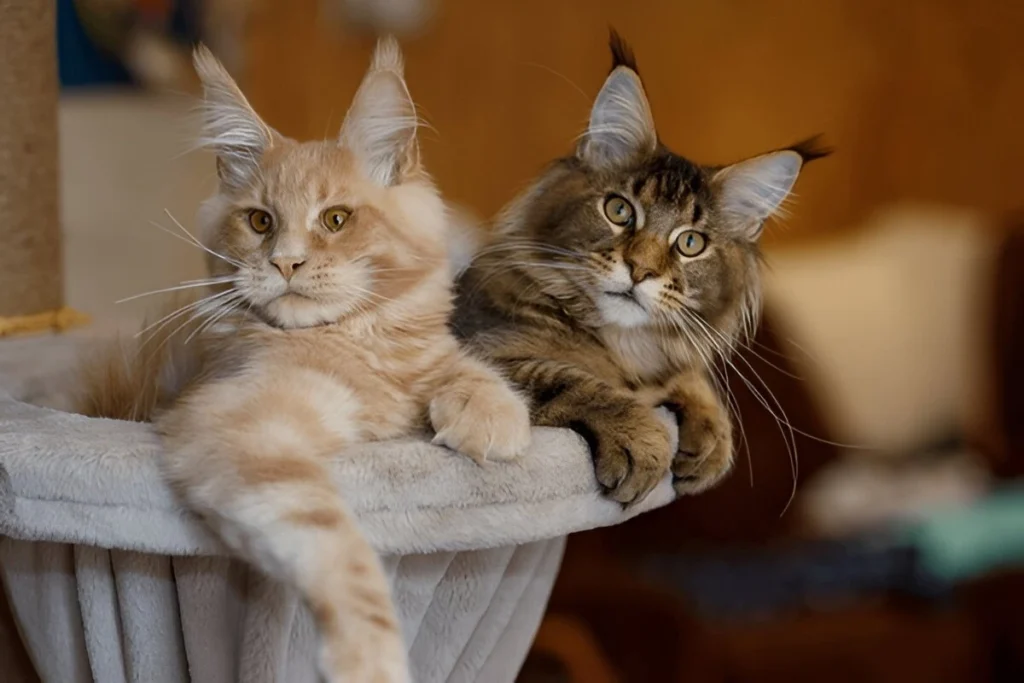
3. Young Adult (Between 2-4 Years)
By the time your Maine Coon is two years-old, you will begin to see a real change. They will not be the uncoordinated ‘teenagers’ they were, but neither are they full-grown cats.
By the age of two, most Maine Coons will be at about 75—90% of their adult size, but they will continue to be filling out (muscle, mane, and that spectacular bushy tail!).
Their personalities tend to become more predictable in this age group. While still playful, energy levels, too, will begin to stabilize.
Some cats like black Maine Coons become more needy, looking to chew up laps, while others remain perfectly independent but loyal cats, following you everywhere, even from room to room!
Their territorial instincts may be heightened, and ensuring there is plenty of vertical space as well as resting options around your household is a great idea.
Diet and Health
Nutrition now focuses on adult cat food, but animal protein-based and joint support remain important. Maine Coons tend to gain excessive weight if overfed, so be sure to provide portion control.
It’s equally important to monitor their dental health. This is something else that will compound as the adult teeth settle, and tartar build-up is likely in the adult health stage.
Care Tips
- It is important to brush your cat at least once a week to avoid mats and tangles.
- Regular play sessions and interactive toys will socially engage your Maine Coon while providing physical exercise.
- Annual vet visits are important and it’s essential to be aware that Maine Coons can be prone to breed-related health problems such as heart disease (hypertrophic cardiomyopathy) and joint problems (hip dysplasia).
4. Prime Adulthood (Age 4-6)
Your Maine coon, between the ages of 4 and 6, will likely be in their prime. It is during this stage where your Maine coon is in full condition and size, and their personality is at its fullest – perfecting all the things described up until now.
Male Maine Coons usually weigh between 15 to 25 lbs while the females are a bit smaller, but there is no mistaking either of them for a house cat, They will both have a thick, water-repellent coat that will be full and dense, along with their lion-like mane.
Maine Coons this age love to climb, to perch and to – supervise their family from their “opinionated” places. Of course, they are still playful, but they will also enjoy their long naps and their long stretches of quiet time!
While many will run from each room in the house to follow you and greet your guests at the doorstep, many form quite strong bonds with their family!
Health and Maintenance
If you take your Maine coon to the vet for an annual or bi-annual health-check-ups there is no doubt that the vet will be able to evaluate their heart, kidneys, and joints specifically for health and maintenance issues.
Your Maine coons health starts with proper diet and exercise. Obesity is a consideration for all my Maine Coons, and as such, I’m always looking for healthy feeding options and consideration of their activity and nap time!
Their fur requires brushing to remain healthy and also to help with their shedding.
Recommendations:
- Consider a sturdy cat tree (with 3+ levels) or solid window perch for optimum enjoyment.
- Consider interactive feeders, slow feeders, or puzzle bowls to help break up their meals to bring engagement to their feeding.
- Attention is required for: trimming of their claws, inspection of ear canals for discomfort or signs of infection.
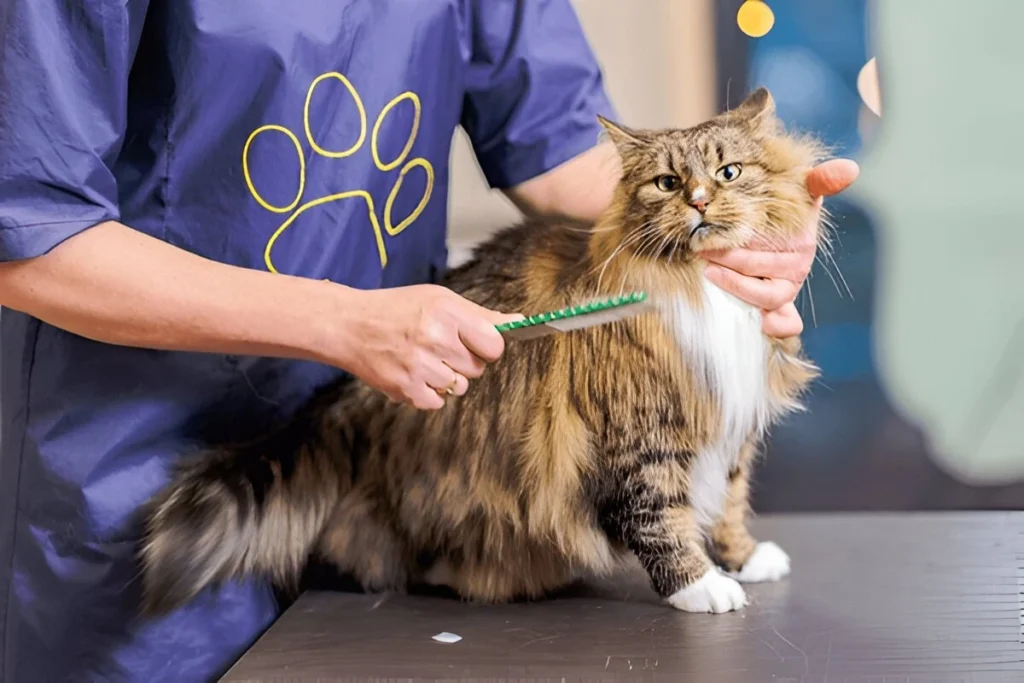
5. Senior Years (7+ Years): The Sage
When your Maine Coon enters their senior phase (7+ years), you will see a noticeable slowdown. You may notice lower activity levels, and your cat may spend a lot of time napping in place in sunny areas.
You may see more signs of joint stiffness or arthritis, which will change their energy socially and/or physically. Changes in appetite may occur; some may have an increase in weight, whereas some will lose weight.
Diet and Health
Changing to a senior food with joint support options, providing a nutrient plan for age-appropriate, easy-to-digest protein options will increase comfort for your cat.
Your vet care plan should include senior care visits when possible (every 6-12 months), so they can catch any age-related issues early.
It’s a good idea to get your cat’s dental care plan thought out early on, as cats over 7 years of age are at risk for dental disease.
Comfort and Emotional Needs
Senior Maine Coons need comfortable environments. Include soft bedding and ramps, where you can, so that they have easy access to their favourite spots!
Maintain their routines and keep things predictable. Give gentle affection, as many older Maine Coons will become more “family-oriented” and enjoy quiet companionship.
Factors That Affect Stages of Growth for the Maine Coon Cat
Each Maine Coon is unique, and multiple factors will dictate how fast or slow your cat grows.
Genetics, being the largest factor, is to begin with (look at the size, weight, and health of your cat’s parents and grandparents).
Nutrition also comes into play; feeding your cat high-quality food in kittenhood gives you the best chance to lay the groundwork for healthy growth and healthy bones.
Health care and veterinary check-ups also play a factor. Only by going to the vet for appropriate check-ups, vaccinations and parasite care will your Maine Coon be able to grow normally, without stunting it’s growth or hindering its growth too greatly.
Environmental impact is important. Having a safe and stimulating home with places to climb or a large enough area to run around will help promote growth both physically and mentally.
The age you choose to spay or neuter can affect growth pattern, but the health and behavioral benefits by far outweigh any effects on growth pattern.
Tracking & Monitoring Growth: Tools and Red Flags
How to Track Growth
- Weigh your kitten every week. Once they start to mature, weigh them monthly.
- Take measurements of body length and height to have a full picture.
- Keep a simple chart or journal with dates and notes.
What is normal?
- Kittens generally have a steady weight gain, and after 6-12 months, their weight gain begins to taper off.
- It is normal for them to have spurts of weight gain and plateaus; just be wary of any sudden changes.
Red Flags
- No weight gain or weight loss in the kitten or young cat.
- If a kitten or young cat is limping, lethargic, or has no appetite.
- If a kitten or young cat’s joints appear swollen, or moving around seems to be a burden.
If you see any of the above characteristics or signs, notice, see your vet as soon as possible.
Embracing Maine Coon Cat Growth Stages
Watching your Maine Coon grow is a special experience; and each Maine Coon growth stage brings you different joys, challenges, and lots of joy, from wobbly kittens, to wise loving elders.
By knowing about Maine Coon Cat Growth Stages, you can give your Maine Coon the best care during this adventure, as well as celebrate each stage and build a lasting bond.
Enjoy each growth stage, take lots of photos, and don’t hesitate to reach out to other Maine Coon owners for support and suggestions. Your gentle giant has a lot of love; you do too!
References:
- https://www.ufaw.org.uk/cats/maine-coon-hypertrophic-cardiomyopathy
- https://www.vet.cornell.edu/departments-centers-and-institutes/cornell-feline-health-center/health-information/feline-health-topics/hip-dysplasia
